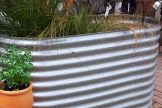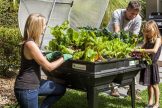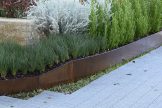
Every garden is its own (or is a unique but connected) ecosystem containing an extraordinary array of living organisms including plants, fungi, bacteria, microbes, insects and animals that all impact on the health and resilience of the living network. We are each the stewards of our gardens, the actions that we take can positively or negatively impact on this ecosystem.
For those wanting a richer range of birds, insects and other visitors, start with providing lots of food and shelter for them. The structure and plant range will determine what insects and animals visit your garden. You can choose plant species to attract specific birds, reptiles, amphibians or insects. Our native blue banded bees are known to be excellent pollinators of tomatoes, Kiwi fruit, eggplants, chilies and macadamias with their sonic buzz pollinating technique. You can encourage them into your garden by having year round flowers, especially blue flowers. If you want lots of native birds, then a wide range of seed and nectar plants will go a long way to encouraging them to visit. Insect hotels provide the perfect space for many beneficial insects to overwinter and to hatch their young. Ponds are good for frogs and provide a water source for all sorts of other garden inhabitants.
Encourage your local native insects, birds and other animals by planting local native (indigenous) species. You don’t have to go entirely indigenous, but mixing some in will help create a natural diversity and benefit the indigenous insects and animals. Even fallen leaves, twigs and branches can provide habitat and food for native animals either directly for through the food web that they help to support.
Why your garden really does matter!
‘No man is an island’ has never been as self–evident as now.
The industrial age of the past 250 years pulled the average person in the industrial economy away from a complex natural world, and into an urban world where the clothes you wear, and the dinner you eat is largely disconnected from animals on farms and crops in the ground. When Apollo 11 landed on the moon, there was a feeling that humanity could control almost anything and define its own destiny. In the more than 50 years since then, it has become apparent that things are not as simple as we initially thought. Deforestation and burning fossil fuels has led to a reduction of the polar icecap via climate change – not even contemplated in 1969 as Neil Armstrong stepped out across the moon. Since then the domino effect of our actions across the world has been accepted. The new appreciation of the interdependence between soil, plants, micro-organisms, insects, and animals has changed the way we farm and led to success in areas like Integrated Pest Management (IPM) and bacterial inoculant fertilisers.
The development of wildlife corridors is another example of the renewed understanding of complex natural ecosystems. If we want our cities to sustain a wide variety of native wildlife, then we need to provide an environment in which they can move from place to place and thrive. This is where your garden comes into the picture. Every garden is its own ecosystem containing an extraordinary array of living organisms including plants, fungi, bacteria, microbes, insects and animals that all impact on the health and resilience of the living network. We are each the stewards of our gardens, the actions that we take can positively or negatively impact on this ecosystem.

No matter where your garden is, inner urban, suburban or rural, it can be a source of food, a safe haven for transitory species, and an essential home and refuge for local inhabitants. Using a wide variety of species that spread flowering times across seasons will help provide food for insects, which in turn will pollinate your vegetables. Adding indigenous plants into your garden can give indigenous insects and animals a leg up in the battle with feral invaders. Many insects have specific adaptations to local flora, the destruction of which has matched a decline in our local insect numbers. The Eltham Copper Butterfly is a good example, its life cycle is closely tied to an ant species and a plant species (Sweet Bursaria). Loss of habitat led to its near extinction, only the careful conservation of its specific habitat will save this butterfly.
Passionate football fans get far more enjoyment from watching their sport than spectators who don’t understand the rules and subtleties of play. So too, does the gardener who appreciates a native blue banded bee feeding in their garden, or a Wattle Bird fighting off an Indian Myna. This is one of the reasons that some of the most passionate gardeners out there are our oldest gardeners, they have had years to learn and observe, to delight in knowledge actively acquired through the years.
It is easy to add indigenous plants, as they are adapted to your climate and soils anyway. They become the work horses of the garden, needing less additional care than plants not naturally suited to the area. Your own garden is your contribution to the wider ecosystem network.





